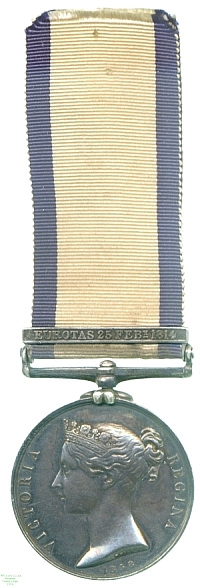
Obverse, a bust of Queen Victoria

Reverse, Britannia with a trident seated sideways on a seahorse

Obverse, a bust of Queen Victoria |

Reverse, Britannia with a trident seated sideways on a seahorse |
Just as in 1848 the extensive land campaigns of the Napoleonic Wars and the other conflicts of the pre-Victorian era were recognised by the issue of the Military General Service Medal, those serving in the Navy at the time were recognised with the Naval General Service Medal. As with the Army equivalent and the East India Company's related award, many of the battles for which the medal was awarded had been fought so long ago that few if any claimants survived.
In addition, bars were awarded for many actions whose significance and size were, despite the heroism displayed by those involved, relatively minor. The result was that many of the bars were issued in tiny numbers, with some combinations all but unique, and the medals command a very high price among collectors because of this rarity and individuality. This in turn, along with the manufacture in most cases of more bars than were eventually issued, has led to the `improvement' of many common awards where recipients' names are shared with those present at `rarer' battles. The medal also shares with the Military General Service and Army of India Medals the oddity that Queen Victoria, whose portrait they bear, was not the ruler under whom the battles for which it was awarded were fought.
One of several single-ship actions for which the NGSM was awarded was the capture of the French frigate Clorinde by HMS Eurotas off Brest. This medal is one of those awarded to the Eurotas's crew, to Ship's Boy John Hampton. His presence on the ship at this time has been verified, and the Medals Roll confirms the award of this medal to a man of this name. It may be noted that Clorinde actually surrendered to HMSS Achates and Dryad, which arrived to help after the two combatants had broken off fighting to repair damage. Clorinde became HMS Aurora.
Lester Watson purchased this medal from the London dealers Baldwin in 1929; it had previously been sold through the London auction house of Glendining in June 1907.